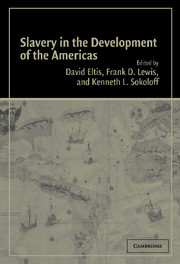Book contents
- Frontmatter
- Contents
- Appreciation: Stanley L. Engerman and Slavery
- Introduction
- PART I ESTABLISHING THE SYSTEM
- PART II PATTERNS OF SLAVE USE
- PART III PRODUCTIVITY CHANGE AND ITS IMPLICATIONS
- 6 Prices of African Slaves Newly Arrived in the Americas, 1673–1865: New Evidence on Long-Run Trends and Regional Differentials
- 7 American Slave Markets During the 1850s: Slave Price Rises in the United States, Cuba, and Brazil in Comparative Perspective
- 8 The Relative Efficiency of Free and Slave Agriculture in the Antebellum United States: A Stochastic Production Frontier Approach
- PART IV IMPLICATIONS FOR DISTRIBUTION AND GROWTH
- The Writings of Stanley L. Engerman
- Contributors
- Index
8 - The Relative Efficiency of Free and Slave Agriculture in the Antebellum United States: A Stochastic Production Frontier Approach
Published online by Cambridge University Press: 18 August 2009
- Frontmatter
- Contents
- Appreciation: Stanley L. Engerman and Slavery
- Introduction
- PART I ESTABLISHING THE SYSTEM
- PART II PATTERNS OF SLAVE USE
- PART III PRODUCTIVITY CHANGE AND ITS IMPLICATIONS
- 6 Prices of African Slaves Newly Arrived in the Americas, 1673–1865: New Evidence on Long-Run Trends and Regional Differentials
- 7 American Slave Markets During the 1850s: Slave Price Rises in the United States, Cuba, and Brazil in Comparative Perspective
- 8 The Relative Efficiency of Free and Slave Agriculture in the Antebellum United States: A Stochastic Production Frontier Approach
- PART IV IMPLICATIONS FOR DISTRIBUTION AND GROWTH
- The Writings of Stanley L. Engerman
- Contributors
- Index
Summary
The relative efficiency of slave agriculture in the American South has stimulated comment and speculation since the mid-nineteenth century. In their path-breaking work on the economics of slavery, Robert Fogel and Stanley Engerman offered the seminal empirical investigation of the relative efficiency of slave agriculture. More recently economists have applied increasingly sophisticated statistical techniques to the investigation.
Despite these contributions, many questions remain unanswered. Among the most important of these is the role that crop mix played in the organization of antebellum agriculture. Large slave plantations grew relatively more cotton than any other Southern farm type, and, obviously, the vast majority of Northern farms grew no cotton at all. In addition, it remains to be determined whether Northern and Southern farms were on different production possibility frontiers (with the higher frontier representing technical superiority), which is a separate question from how close in practice those farms were to their respective frontiers (technical inefficiency). To carry out a comprehensive investigation, such as that suggested by these questions, one must compare the efficiency of North v. South, Old South v. New South, and free v. slave farms, employing econometric techniques designed for such a task. For these comparisons to be meaningful, the analysis must control for variations in crop mix, with cotton production being the key factor.
Unlike previous contributions, this paper controls for the effect of cotton's share of output, treating that variable as endogenous.
- Type
- Chapter
- Information
- Slavery in the Development of the Americas , pp. 236 - 258Publisher: Cambridge University PressPrint publication year: 2004
- 1
- Cited by

